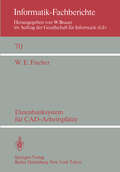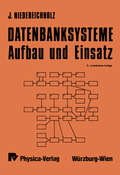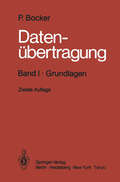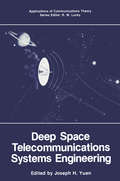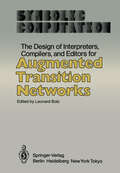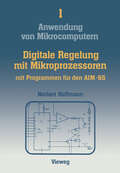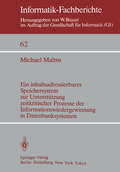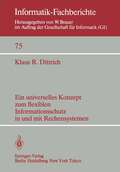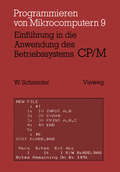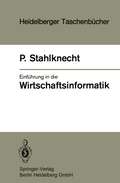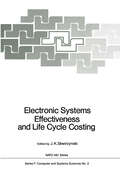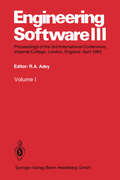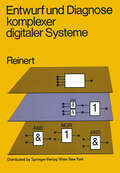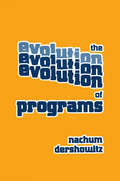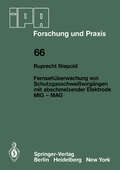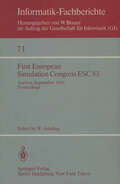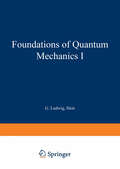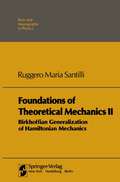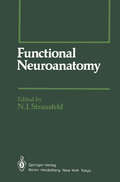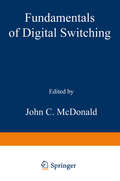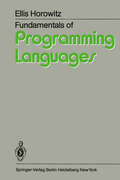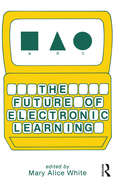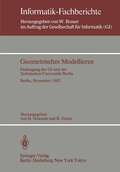- Table View
- List View
Datenbanksysteme: Aufbau und Einsatz
by J. NiedereichholzDas vorliegende Werk möchte auf anschauliche Art und Weise in die Funktionsweise und Einsatzproblematik von Datenbanksystemen einführen. Leider ist die Implementierung von Datenbanksystemen nicht immer einfach zu erläutern. Das Werk enthält deshalb einige Kapi tel zur Datenorganisation, die gewisse Vorkenntnisse beim Leser erwarten. Der Leser sollte ein grundsätzliches Verständnis der Abläufe in EDV-Systemen besitzen und die eine oder andere Programmiersprache kennen, wobei er sie nicht unbedingt gut beherrschen muß. Das Werk entstand aus Vorlesungen, universitätsinternen und -externen Seminaren sowie eigenen Datenbanksystemtests und -einsatzerfahrungen. Es ist in manchen Teilen ausgespro chen praktisch orientiert, da Datenbanksysteme nicht sinnvoll ohne die Erörterung heutiger Implementierungstechniken abgehandelt werden können. Es soll deshalb gleichermaßen die Bedürfnisse von Studenten der Wirtschaftswissenschaften, Informatik und nahestehender Be reiche wie auch von Praktikern der EDV befriedigen. Herrn Dipl.-Volkswirt Chr. Wentzel danke ich für die Unterstützung bei der Abfassung des Manuskriptes und der Zeichnungen. Die Struktur des Werkes ist folgendermaßen aufgebaut: SOFT TEST IF KETT HASH FREI KaMP VGL SICH ENTW Das Kapitel SOFT führt in die Software-Komponenten von Datenbank-Systemen ein. Da der Test von Datenbanksystemen ein besonders problematischer Punkt ist, wurde ein eige nes Kapitel TEST eingebaut. Hieran schließen sich die Detail-Kapitel IX, IF, KETT, HASH, FREI und KaMP an, in denen sozusagen die Interna der Datenorganisation und die damit zusammenhängende Problematik von Datenbanksystemen veranschaulicht werden. In Kapitel VGL werden die behandelten Methoden noch einmal gegenübergestellt, damit unter dem Eindruck der Fülle von Verfahren der Überblick und Vergleich nicht verloren geht.
Deep Space Telecommunications Systems Engineering (Applications of Communications Theory)
by Joseph H. YuenThe challenge of communication in planetary exploration has been unusual. The guidance and control of spacecraft depend on reliable communication. Scientific data returned to earth are irreplaceable, or replaceable only at the cost of another mission. In deep space, communications propagation is good, relative to terrestrial communications, and there is an opportunity to press toward the mathematical limit of microwave communication. Yet the limits must be approached warily, with reliability as well as channel capacity in mind. Further, the effects of small changes in the earth's atmosphere and the interplanetary plasma have small but important effects on propagation time and hence on the measurement of distance. Advances are almost incredible. Communication capability measured in 18 bits per second at a given range rose by a factor of 10 in the 19 years from Explorer I of 1958 to Voyager of 1977. This improvement was attained through ingenious design based on the sort of penetrating analysis set forth in this book by engineers who took part in a highly detailed and amazingly successful pro gram. Careful observation and analysis have told us much about limitations on the accurate measurement of distance. It is not easy to get busy people to tell others clearly and in detail how they have solved important problems. Joseph H. Yuen and the other contribu tors to this book are to be commended for the time and care they have devoted to explicating one vital aspect of a great adventure of mankind.
The Design of Interpreters, Compilers, and Editors for Augmented Transition Networks (Symbolic Computation)
by Leonard BolcAugmented Transition Network Grammars are at present the most widely used method for analyzing natural languages. Despite the increasing po pularity of this method, however, no extensive papers on ATN-Grammars have been presented which would be accessible to a larger number of per sons engaged in the problem from both the theoretical and practical points of view. Augmented Transition Networks (ATN) are derived from state automata. Like a finite state automaton, an ATN consists of a collection of la beled states and arcs, a distinguished start state and a set of distin guished final states. States are connected with each other by arcs crea ting a directed graph or net. The label on an arc indicates a terminal symbol (word) or the type of words which must occur in an input stream to allow the transition to the next state. It is said that a sequence of words (or sentence) is accepted by such a net if there exists a se quence of arcs (usually called a path), connecting the start state with a final state, which can be followed to the sentence. The finite state automaton is then enriched by several facilities which increase its computational power. The most important of them permits some arcs to be labeled by nonterminal rather than terminal symbols. This means that the transition through such an arc is actually the re cursive application of the net beginning with a pointed state.
Dokumentations- und Ordnungslehre: Lehrbuch für die Theorie und Praxis des Information Retrieval
by W. GausEin inhaltsadressierbares Speichersystem zur Unterstützung zeitkritischer Prozesse der Informationswiedergewinnung in Datenbanksystemen (Informatik-Fachberichte #62)
by M. MalmsEin universelles Konzept zum flexiblen Informationsschutz in und mit Rechensystemen (Informatik-Fachberichte #75)
by K. R. DittrichEinführung in die Anwendung des Betriebssystems CP/M (Programmieren von Mikrocomputern #9)
by Schneider WolfgangElectronic Systems Effectiveness and Life Cycle Costing (NATO ASI Subseries F: #3)
by J. K. SkwirzynskiThis volume contains the complete proceedings of a NATO Advanced Study Institute on various aspects of the reliability of electronic and other systems. The aim of the Insti~ute was to bring together specialists in this subject. An important outcome of this Conference, as many of the delegates have pointed out to me, was complementing theoretical concepts and practical applications in both software and hardware. The reader will find papers on the mathematical background, on reliability problems in establishments where system failure may be hazardous, on reliability assessment in mechanical systems, and also on life cycle cost models and spares allocation. The proceedings contain the texts of all the lectures delivered and also verbatim accounts of panel discussions on subjects chosen from a wide range of important issues. In this introduction I will give a short account of each contribution, stressing what I feel are the most interesting topics introduced by a lecturer or a panel member. To visualise better the extent and structure. of the Institute, I present a tree-like diagram showing the subjects which my co-directors and I would have wished to include in our deliberations (Figures 1 and 2). The names of our lecturers appear underlined under suitable headings. It can be seen that we have managed to cover most of the issues which seemed important to us. VI SYSTEM EFFECTIVENESS _---~-I~--_- Performance Safety Reliability ~intenance ~istic Lethality Hazards Support S.N.R. JARDINE Max. Vel. etc.
Engineering Software III: Proceedings of the 3rd International Conference, Imperial College, London, England. April 1983
by R. A. AdeyThese proceedings contain the papers presented at the Third International Conference and Exhibition on Engineering Software held at Imperial College, London during the period April 11th - 13th, 1983. I must thank again the authors who submitted the large numbers of papers which made selection a difficult task. The theme of the conference is the use and application of computers in engineering. Many abbreviations have been invented to describe the use of computers from CAD, CAM, CADMAT etc. but the term which best describes the scope of the conference is Computer Aided Engineering, CAE. The papers have been split into sections covering different application areas such as Mechanical Engineering, Civil Engineering. Other sections cover techniques such as Finite Elements, Boundary Elements and General Simu lation. An important session at the conference was the new field of engineering databases and as in past conferences the special sessions were devoted to microcomputers. R.A. ADEY (EDITOR) ENGINEERING SOFTWARE DESIGN 3 MENU INPUT GENERATING SYSTEM FOR THE FORTRAN PROGRAMS I. Kovacic Institute of Structural and Earthquake Engineering Department of Civil Engineering University "Edvard Kardelj" of Ljubljana, Yugoslavia INTRODUCTION Although fortran Is losing competition with the new languages it Is still very used programming language, especially in the technical software production. Technical tasks are not to be described by a lot of data usually, as in business applications.
The Evolution of Programs (Progress in Computer Science and Applied Logic #5)
by DERSHOWITZ-Ecclesiastes 12:12 Programs are invariably subjected to many rorms or transrormation. After an initial version of a program has been designed and developed, it undergoes debugging and certification. In addition, most long-lived pro grams have a liCe-cycle that includes modifications to meet amended specifications and extensions for expanded capabilities. Such evolution ary aspects of programming are the topic of this monograph. We present rormal methods for manipulating programs and illustrate their applica tion with numerous examples. Such methods could be incorporated in semi-automated programming environments, where they would serve to ease the burden on the programmer. We begin by describing a method whereby a given program that achieves one goal can be modified to achieve a different goal or a pro gram that computes wrong results can be debugged to achieve the 2 Preface intended results. The abstraction of a set of cognate programs to obtain a program schema, and the instantiation of abstract schemata to solve concrete problems, are approached from the same perspective. In addition, we describe synthesis rules for generating code from specifications and annotation rules for making assertions about code. The synthesis rules may be used when a program is first being developed, or when, in the course of modifying a program, the need arises to rewrite a program segment. Annotation rules may be used for the purpose of determining what an incorrect program really does before attempting to debug it or how a correct program works before attempting to modify it.
Fernsehüberwachung von Schutzgasschweißvorgängen mit abschmelzender Elektrode MIG — MAG (IPA-IAO - Forschung und Praxis #66)
by R. NiepoldFirst European Simulation Congress ESC 83: Aachen, September, 12–16, 1983 Proceedings (Informatik-Fachberichte #71)
by W. AmelingWelcome to Aachen and to the First European Simulation Congress ESC83, a triennial international conference jointly promoted by ASIM/GI, DBSS, SIMS and UKSC. ESC83 is organized by ASIM/GI,. supported by SCS and IMACS, and sponsored by NGI (section for simulation). It takes place at the Karman Auditorium of the Aachen Technical Univer sity, FRG. The aim of ESC83 is to cover all aspects of modeling and simulation in theory and practice, to promote the exchange of knowlewdge and experience between different international research groups in this field, and to strengthen the international contact between developers and users of modeling and simulation techniques. On the occasion of the Congress people of scientific and engineering disciplines will meet to discuss the state of the art and future activities and developments. A large number of contributed papers has been strictly examined and selected by the Scientific Committee to guarantee a high international standard. The book contains the accepted papers that will be presented at the Congress. The papers have been classified according to the following keywords.
Foundations of Theoretical Mechanics II: Birkhoffian Generalizations of Hamiltonian Mechanics (Theoretical and Mathematical Physics)
by Ruggero Maria SantilliIn the preceding volume,l I identified necessary and sufficient conditions for the existence of a representation of given Newtonian systems via a variational principle, the so-called conditions of variational self-adjointness. A primary objective of this volume is to establish that all Newtonian systems satisfying certain locality, regularity, and smoothness conditions, whether conservative or nonconservative, can be treated via conventional variational principles, Lie algebra techniques, and symplectic geometrical formulations. This volume therefore resolves a controversy on the repre sentational capabilities of conventional variational principles that has been 2 lingering in the literature for over a century, as reported in Chart 1. 3. 1. The primary results of this volume are the following. In Chapter 4,3 I prove a Theorem of Direct Universality of the Inverse Problem. It establishes the existence, via a variational principle, of a representation for all Newtonian systems of the class admitted (universality) in the coordinates and time variables of the experimenter (direct universality). The underlying analytic equations turn out to be a generalization of conventional Hamilton equations (those without external terms) which: (a) admit the most general possible action functional for first-order systems; (b) possess a Lie algebra structure in the most general possible, regular realization of the product; and (c) 1 Santilli (1978a). As was the case for Volume I, the references are listed at the end of this volume, first in chronological order and then in alphabetic order.
Functional Neuroanatomy (Springer Series in Experimental Entomology)
by M. E. Adams J. S. Altman J. P. Bacon U. K. Bassemir C. A. Bishop E. Buchner H. Bülthoff S. D. Carlson Chi Che F. DelComyn H. Duve M. Eckert T.R.J. Flanagan G. Geiger C. H. Hackney B. Hengstenberg R. Hengstenberg N. Klemm D. R. Nässel M. O Shea W. A. Ribi R.L. Saint Marie H. S. Seyan P. T. Speck N. J. Strausfeld A. Thorpe J. Ude D. W. WohlersThe "functional" in the title of this book not only reflects my personal bias about neuroanatomy in brain research, it is also the gist of many chapters which describe sophisticated ways to resolve structures and interpret them as dynamic entities. Examples are: the visualization of functionally identified brain areas or neurons by activity staining or intracellular dye-iontophoresis; the resolution of synaptic connections between physiologically identified nerve cells; and the biochemical identification of specific neurons (their peptides and transmitters) by histo- and immunocytochemistry. I personally view the nervous system as an organ whose parts, continuously exchanging messages, arrive at their decisions by the cooperative phenome non of consensus and debate. This view is, admittedly, based on my own ex perience of looking at myriads of nerve cells and their connections rather than studying animal behaviour or theorizing. Numerous structural studies have demonstrated that interneurons in the brain must receive hundreds of thousands of synapses. Many neurons receive inputs from several different sensory areas: each input conveys a message about the external world and possibly also about past events which are stored within the central nervous system. Whether an interneuron responds to a certain combination of inputs may be, literally, a matter of debate whose outcome is decided at the post synaptic membrane. A nerve cell responding to an overriding command is possibly a rare event.
Fundamentals of Digital Switching (Applications of Communications Theory)
by John C. McDonaldThe development of low-cost digital integrated circuits has brought digital switching from a concept to an economic reality. Digital switching systems have now found worldwide acceptance and there are very few new switch ing systems being considered either for design or application which are not digital. Digital technology has created new opportunities for innovation including the integration of digital transmission and switching, the combi nation of voice and data services in one switching entity, and the design of switching systems which are economical over a broad range of sizes. In the strict sense, the term "digital switching" refers to a system which establishes a message channel between two terminations where infor mation is represented in digital form. In more common usage, a digital switch usually contains a time-divided network composed of logic gates and digital memory to accomplish the switching function. The intent of this book is to provide an introductory level explanation of the principles of digital switching. These principles apply to both public and PABX switching. The book is aimed at those who apply, design, main tain, or simply wish to understand digital switching techniques. An electri cal engineering degree is definitely not required for comprehension. We have concentrated on explaining digital switching techniques without the use of detailed mathematics. However, each chapter contains a comprehen sive list of references which will lead the reader to sources for a more in-depth study of the many subjects covered.
Fundamentals of Programming Languages
by E. Horowitz" .. .1 always worked with programming languages because it seemed to me that until you could understand those, you really couldn't understand computers. Understanding them doesn't really mean only being able to use them. A lot of people can use them without understanding them." Christopher Strachey The development of programming languages is one of the finest intellectual achievements of the new discipline called Computer Science. And yet, there is no other subject that I know of, that has such emotionalism and mystique associated with it. Thus my attempt to write about this highly charged subject is taken with a good deal of caution. Nevertheless, in my role as Professor I have felt the need for a modern treatment of this subject. Traditional books on programming languages are like abbreviated language manuals, but this book takes a fundamentally different point of view. I believe that the best possible way to study and understand today's programming languages is by focusing on a few essential concepts. These concepts form the outline for this book and include such topics as variables, expressions, statements, typing, scope, procedures, data types, exception handling and concurrency. By understanding what these concepts are and how they are realized in different programming languages, one arrives at a level of comprehension far greater than one gets by writing some programs in a vi vB Preface few languages. Moreover, knowledge of these concepts provides a framework for understanding future language designs.
The Future of Electronic Learning
by M. A. WhiteFirst Published in 1983. Routledge is an imprint of Taylor & Francis, an informa company.
The Future of Electronic Learning
by Mary Alice WhiteFirst Published in 1983. Routledge is an imprint of Taylor & Francis, an informa company.
